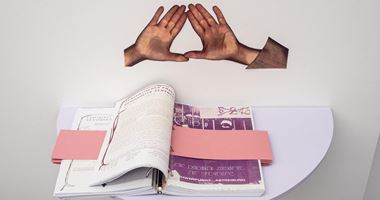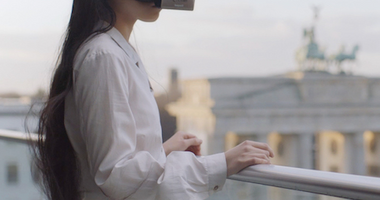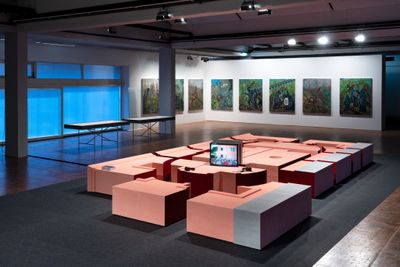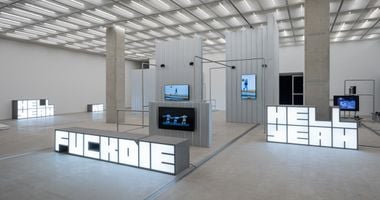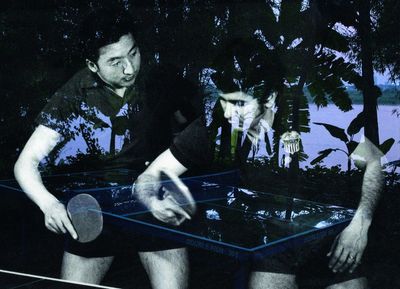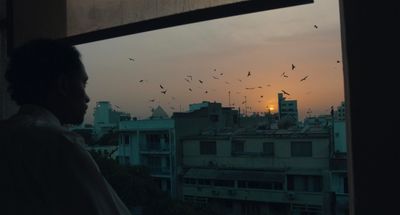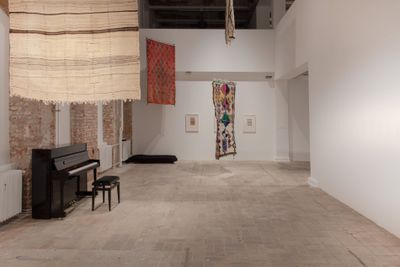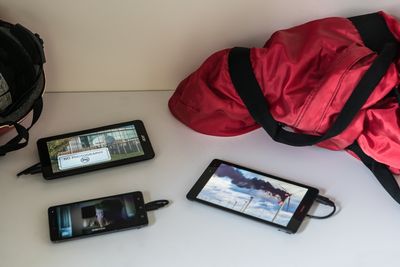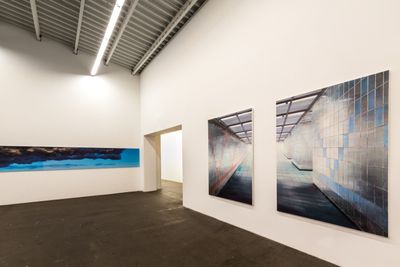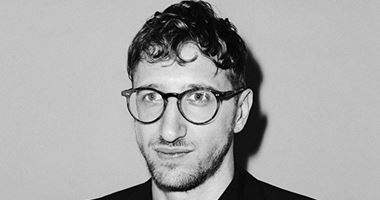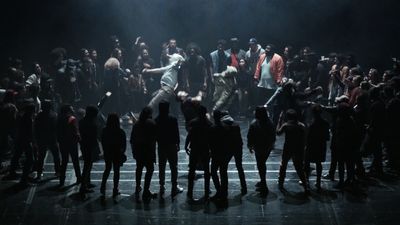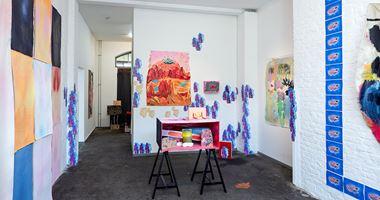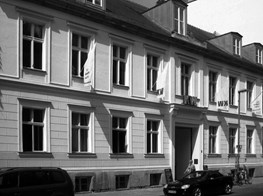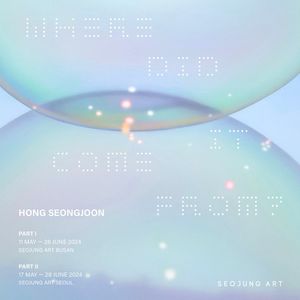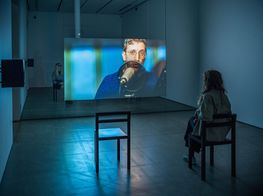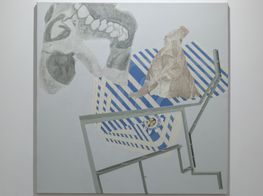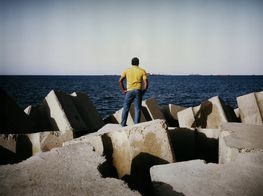In 2022, the Berlin Biennale Is at a Standstill
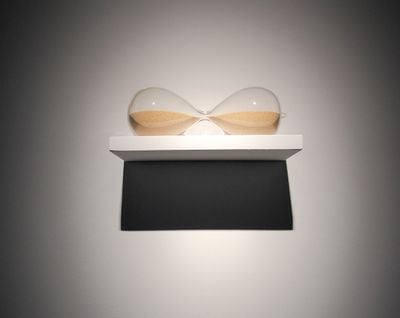
Taysir Batniji, Suspended Time (2006). Glass, sand. Exhibition view: 12th Berlin Biennale, KW Institute for Contemporary Art, Berlin (11 June–18 September 2022). Courtesy Berlin Biennale. Photo: Silke Briel.
The Berlin Biennale seems to be at a standstill, and not only because of its 2022 title Still Present! (11 June–18 September).
The institution's current state is best reflected in its 12th edition by a small but powerful work, Suspended Time (2006), by Palestinian artist Taysir Batniji—a horizontal hourglass on a high shelf with sand divided equally between both sides.
Spread across the KW Institute for Contemporary Art main venue and several other spaces, including Akademie der Künst at Hanseatenweg and Pariser Platz, Hamburger Bahnhof, and the Stasi Museum of the old East German secret police, Still Present! revisits anti-colonial grievances that similarly characterised the Biennale's last two editions.
All three have focused on the adverse impacts of modernity on the colonised geographies outside Europe and North America and individuals and marginalised groups inside these privileged colonial zones.
However, this is the first time the majority of artists featured in the show—curated by artist Kader Attia with an all-female artistic team consisting of Ana Teixeira Pinto, Đỗ Tường Linh, Marie Helene Pereira, Noam Segal, and Rasha Salti—hail from North Africa and the Arab world.
What is also different is the embrace of scale and immersion, with experiential works installed in large spaces involving expensive visual technologies—perhaps fuelled by the addition of Hamburger Bahnhof's left-wing building to the Biennale's designated sites. The structure's large, secluded areas offer ample room to realise immersive projects; an attempt that seems to have exhausted a large sum of the exhibition budget without achieving an impact that justifies the expenditure.
For example, Thuy-Han Nguyen-Chi's video installation This undreamt of sail is watered by the white wind of the abyss (2022), sits on a large platform adorned with broken ostrich eggs and an oxygen mask. Its centre is furnished with an object that crosses a hospital bed with a fishing boat, above which hangs a screen displaying a video co-directed with the artist's mother.
Multiple storylines delivered through narrative fragments follow a woman's journey from Vietnam to Thailand and Germany after the Vietnam War. Yet the set's excessive stylisation, combined with the story's romantic tone and monotonous narration, reduce the heavy political content to congenial anti-colonial pastiche.
Another large-scale installation is Tuan Andrew Nguyen's four-screen video work, The Specter of Ancestors Becoming (2019), produced with Vietnamese-Senegalese collaborators in Dakar and Malika in Senegal. Through flashbacks and written letters, the video tracks three stories of displaced Senegalese soldiers from the French colonial army, who married Vietnamese women and later returned to their home country, with or without their wives and children.
Despite the narrative's moving focus on the personal and psychological impacts of colonialism and war, it is difficult to follow the story, as its plot moves haphazardly from screen to screen, devoid of logic, perhaps exacerbated by the overlaid music and the sound work.
Even Forensic Architecture's brilliant two-channel installation Cloud Studies (2022), falls victim to an unnecessary attempt to create a grandiose, immersive experience. Projected on a large, semi-circular screen, the video and accompanying wall text investigate how repressive states using corporate technology utilise tear gas, chlorine, and white phosphorus to 'colonise' air.
These toxic operations not only affect their political targets but the world's inhabitants, making the planet less liveable. The unresolvable contradiction here, heightened by the projection's scale, is between the spread of gas through the air and the gorgeous pictures displaying the act.
In the best-case scenario, these large-scale installations arrive at a more self-reflective version of the post-internet trend that marked the Biennale's 2016 edition, curated by the DIS collective, which was heavily criticised for its obsession with the technological surface.
A case in point is Profundior (Lachryphagic Transmutation Deus-Motus-Data Network) (2022) by Zach Blas, one of the only works to deal with the horrors of an automated and algorithmic world both in form and content.
In this ten-channel video installation, a cacophony of vertical digital screens includes six that display still images of religious texts developed by training a neural network to read and understand spiritual manuscripts, while two show large, digital but human-looking eyes crying tears and blood.
Thick, hanging black tubes connect the screens, leading to a round digital pool in the centre—supposedly the result of an A.I.-generated scheme to reflect the extraction of human emotions to train artificial eyes and study people's affective threshold against corporate manipulation.
Beyond these questionably effective mega installations, other small works invite a more intimate viewing experience. At the Akademie Der Künst, Dana Levy's History Lessons (2022) is a rectangular composite comprised of 77 historic magic-lantern slides depicting landscapes and faces from the Americas and pre-Israel Palestine.
The Berlin Biennale seems to be at a standstill, and not only because of its 2022 title Still Present!
Mounted on a 50-inch flat-screen television, the slides appear to be overlaid with dotted screens that increase their contrast, making them appear as if they have digital origins. The artist programmed the monitor beneath to display footage of flashing lightning, which illuminates the slides following particular patterns, giving the composite frame a shimmering sentient presence.
At the KW Institute for Contemporary Art, Myriam El Haïk's installation and performance Please Patterns (2022) includes a piano piece, a series of two paintings, and a graphite-and-pencil drawing on the wall, Please Patterns Notations (2022); while the two drawings of Time Square (2022) are meticulously made with hundreds of square-shaped criss-cross markings with colour pens in perfect grids.
The smallest and most intimate work across the show must be Omer Fast's A Place Which Is Ripe (2020). Installed in a locker used by Stasi Museum visitors, complete with hanging shirts and a jacket that could belong to a German security officer, are three phone screens with German audio and English subtitles. Together, they present the artist's investigation into different surveillance regimes in England and Germany.
Through interviews with security experts, Fast contrasts the older U.K. system, with the increase of closed-circuit cameras helping to solve murders in the 1990s, to the emerging networked alternative in Germany, where cellphone footage helped arrest suspects following a sexual assault incident across German cities on New Year's eve in 2015.
Among the best-executed works is the digital installation Air Conditioning (2022) by Lawrence Abu Hamdan. The horizontal digital print of a cloudy sky wraps around a large space, detailing Israeli violations of Lebanese airspace between 2006 and 2021.
The work's shifting colours reflect the density of these intrusions, visualised as a form of pollution, while an accompanying website offers viewers different ways to understand these violations' breadth and depth.
Another striking work is Clément Cogitore's emotionally charged Les Indes Galantes (2017). The video shows Afrodiasporic multiracial dancers battling on a stage to the rhythms and melodies of Jean-Philippe Rameau's 1735 opera-ballet of the same name.
Surprisingly, however, neither the catalogue nor the exhibition didactic mention the work's choreographer Bintou Dembélé, erasing a crucial collaborator without whom the work could have not been produced.
Nevertheless, Cogitore's document of human struggle and triumph captures a set of affectual body movements, confronting not only the realities of being Black in a world that sees colour but the difficult negotiations that ought to happen to reach a balance between Europe and the diasporic communities living within it.
But while significant, these latter works seem adrift in an exhibition suffocated by a monotonous chorus of political slogans. My hope is that after this iteration, the Berlin Biennale may set its sights on new curatorial and aesthetic horizons. —[O]

